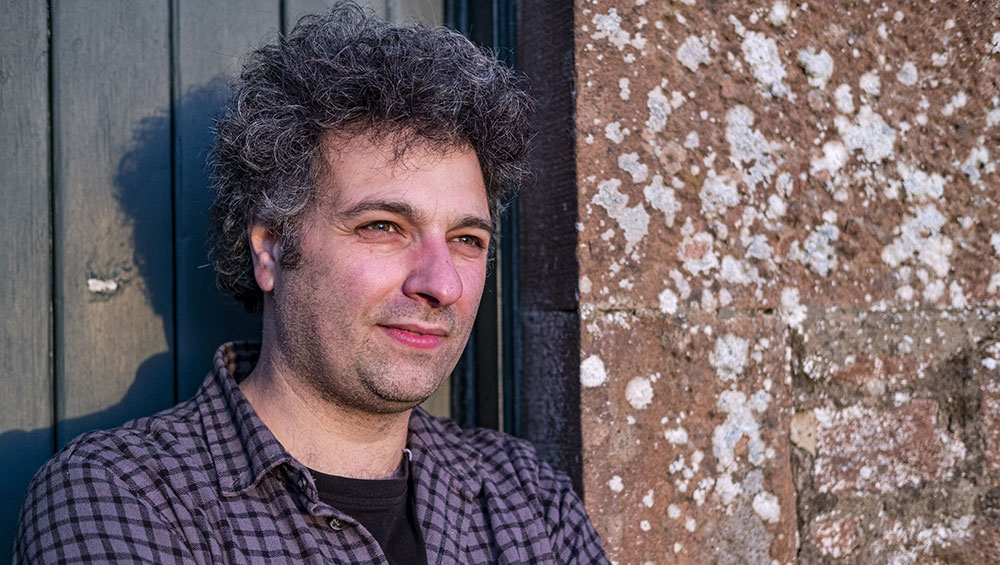
Michael Visocchi. Photo: Adam Proctor.
by JULIET RIX
The Scottish sculptor Michael Visocchi lives and works in an old schoolhouse in Angus (halfway between Edinburgh and Aberdeen), using a variety of materials, including wood, metal, thread and card, to make works that often address nature, landscape and the human trace on it. Born in 1977, he grew up in his parents’ shops and cafes. After a brief time apprenticed to a cabinet-maker, he began training as an architect, but found he preferred more hands-on making. He transferred to study sculpture, and graduated from Glasgow School of Art in 2001.
To make ends meet while establishing his own practice, he worked in the city, making everything from furniture and theatre sets to other artists’ sculptures. Then, just four years out of art school, at the age of 27, he became the youngest artist ever to be elected to the Royal Scottish Academy. In 2009, he won the Jerwood Sculpture Prize for Yield, a proposed 18-metre-high piece composed of two pylons. The design was meant to become a full-scale, permanent sculpture, but – ironically, given the subject matter – planning permission was refused.
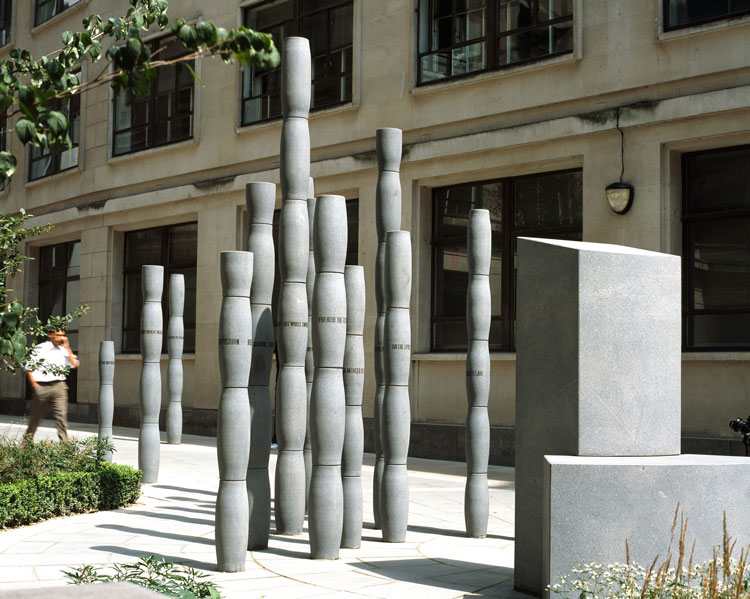
Michael Visocchi. Gilt of Cain, 2008. Granite, 30 x 10 metre area, columns various heights. © Michael Visocchi.
Visocchi has produced a number of public art works, most notably Gilt of Cain, in the City of London, which was unveiled by Desmond Tutu. Inscribed with words by the poet Lemn Sissay, the work commemorates the bicentenary of the abolition of the trans-Atlantic slave trade in 1807.
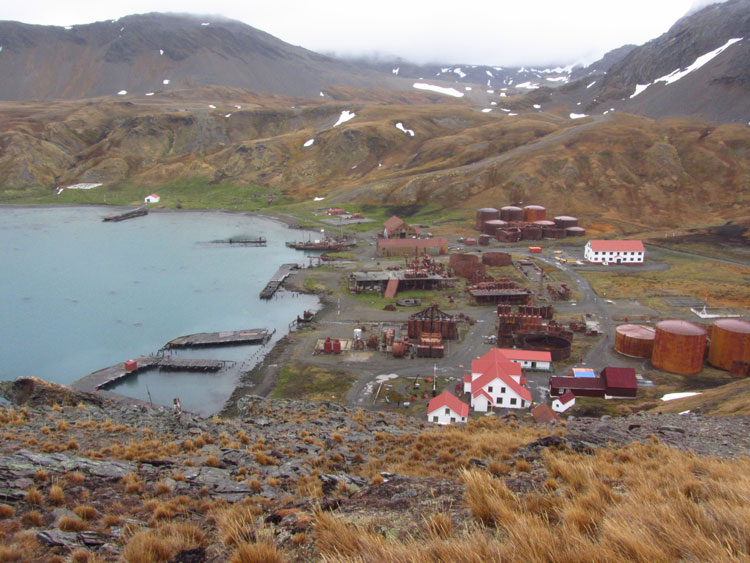
Grytviken, South Georgia. Photo: Juliet Rix.
Visocchi’s latest commission will have a less accessible setting and an audience of penguins and seals in addition to any visiting humans. South Georgia, a British Overseas Territory in the middle of the southern Atlantic, is just north of the Antarctic Circle and one of the most isolated places on Earth. It lies two days by sea from the Falkland Islands and a similar distance from the Antarctic Peninsula – and a ship across the often rough waters is the only way to get there. Most of the island has never been set foot on, and there is no permanent settlement (just two government officers and their spouses, a few British Antarctic Survey scientists, and four museum staff in summer). Yet human activity here from the end of the 18th century to the mid-20th century almost led to the destruction of its spectacular wildlife. Hunting decimated the whale population and, before that, almost wiped out the fur seal (South Georgia is home to 95% of the world population), while the accidental introduction of rodents from the hunters’ ships nearly did the same for the birds in this globally important breeding zone. Extraordinarily, South Georgia is now a rare environmental good news story – an ecosystem in recovery. Whale populations are rising, fur seals are once more present in their thousands, and a £10m decade-long rodent eradication project – the largest in the world – has entirely rid South Georgia of rats. Birds are once again breeding in peace and their numbers burgeoning.
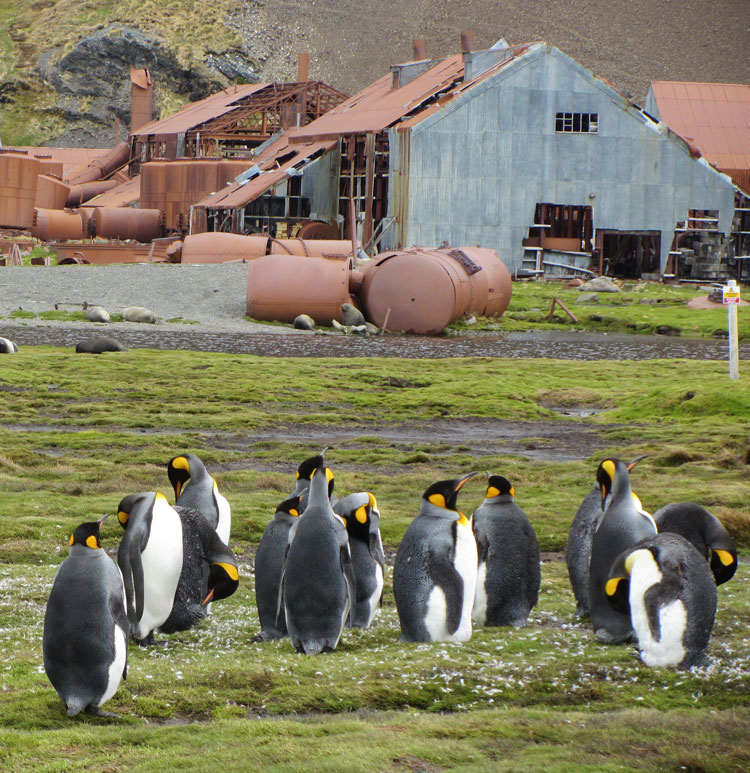
Grytviken, South Georgia. Photo: Juliet Rix.
It is to celebrate this turnaround that the Dundee-based South Georgia Heritage Trust and the government of South Georgia and the South Sandwich Islands decided to commission a monumental work of art for Grytviken, the old whaling station, the remains of which still stand rusting evocatively at the water’s edge. More than 150 artists from around the world applied for the commission, and a judging panel, which included Creative Scotland, chose Visocchi’s Commensalis: The Spirit Tables of South Georgia.
Visocchi spoke to Studio International via Zoom from his home in Scotland.
Juliet Rix: How did you hear about this commission?
Michael Visocchi: I’d usually see such things advertised in artists’ periodicals, but this time I was busy and would have missed it if a friend, also a sculptor and somewhat of a mentor to me, hadn’t told me about it. In my 30s, I used to apply for commissions just because I thought I should get work, but I’ve learned the hard way to apply only if I really feel it. I really felt this one.
I spent about two weeks – unpaid – putting together a proposal. I’m not a great writer and it isn’t easy expressing visual ideas on paper. And you’re always trying to withhold a bit in case the idea changes in your head. That was almost a year ago. It’s been a long process, delayed further by the pandemic. I was eventually longlisted – a list of 21 artists – then tried to put it from my mind. I finally heard I was in the last three in March, just after our beloved dog had died and we’d all gone into lockdown. It was a strange time and that perhaps intensified the project for me.
JR: In what way?
MV: This project is in a way all about numbers – the extraordinary number of whales taken by the whalers. And in the pandemic, we were drip-fed statistics every day. The pandemic brought home how interconnected we all are, how reliant on one another we are across nations (and this after four years of Trump). The pandemic has been terrible for so many people, but perhaps we should consider it a dry run for what we have to understand to deal with climate change. I’ve been focused on this subject for a long time, but I think the pandemic and this project have heightened it for me.
JR: Did you already know about South Georgia?
MV: I had been aware of the island for a long time. I was obsessed with David Attenborough as a child in the 80s. I still have my copy of The Trials of Life, which came out in 1990. I forgot about it all in my teens and early 20s, but more recently came back to it in my practice.
We are obsessed with island cultures: Crete, Iona, Atlantis … and South Georgia has an almost mythical quality because of its remoteness. Interestingly, Crete and South Georgia are a similar size. Crete is like a crucible of human ideas and has such an ancient human footprint on it. South Georgia has only 250 years of human contact. Crete contains fairly narcissistic stories all about us – about wealth and power and human aspirations. South Georgia by comparison has a kind of pureness about it.
JR: South Georgia has only 250 years of human contact, but we nearly destroyed it.
MV: Yes, we brought war to its shores and decimated its wildlife.
JR: Though arguably we humans are also now bringing it back?
MV: That is something the commissioners of this work are really keen for the artist to emphasise – the hope – that if you do the right thing, things will recover. It’s quite amazing really. It would be easy to alight on the negative aspects of whaling and memorialise that. What I think they saw in my idea was also that sense of hope.
JR: What is your idea?
MV: The commission was – unusually for public art – specified as requiring a site-specific response from the artist. I had a tutor at art school who used to say to us: “The site is half the work.” It was such a good thing to say to a bunch of young artists; it subjugates the artist’s ego. And it’s true; you come to sculpture through the context – the place, weather, light, how you experience it. I think this commission is an exception though. In this case, the context could almost be 90% of the work.
The commission brief was probably the most thorough and detailed I’ve seen. It was delivered in partnership with an art agency based in Aberdeen called Smart. South Georgia Heritage Trust and the art agency were incredibly supportive and keen to provide any extra information I needed throughout the research period.
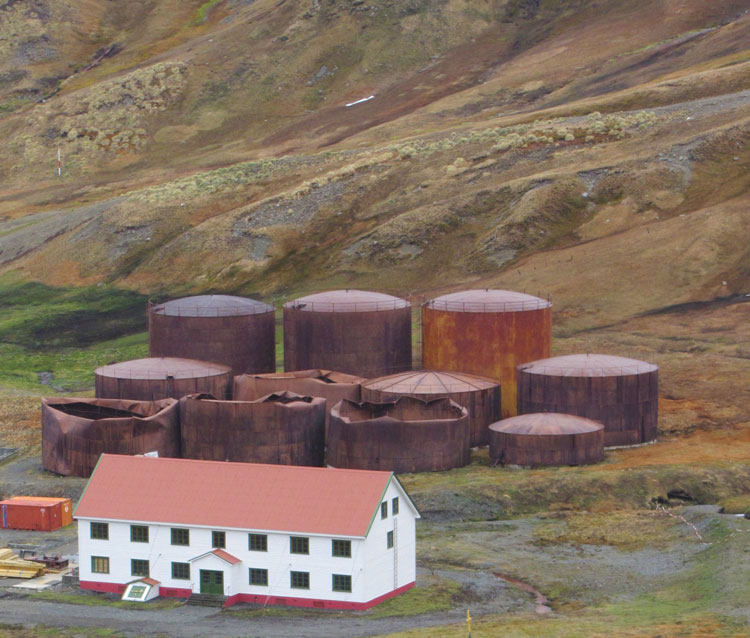
Grytviken, South Georgia. Photo: Juliet Rix.
The site is the old whaling station of Grytviken, and specifically the Flensing Plan, an area of 40m2 that visitors often bypass. It’s where thousands of whales were dragged up and their skin and blubber cut off. It’s a pretty charged place and anything put there has to reflect that, but still be hopeful. The story is essentially about numbers and I needed a unit to express those numbers visually. Grytviken has an abandoned farmyard quality. It’s full of rusty metal structures held together with rivets. The equipment came flat-packed from Norway and was assembled on-site in the 1910s. I’ve always been interested in rivets – fixings. If you see a structure that’s peppered with rivets, then the points of shade they create can articulate and emphasise the form. The rivets gave me my unit.
I also remembered the Attenborough films about whales and the [rivet-like] barnacles on the animals’ sides. I started to read about the connection between barnacles and whales. It’s a commensal relationship, where one species benefits and the other doesn’t, but is not harmed. The barnacles are the ones that benefit and the whale, while not benefiting, is not harmed. Although some species of whale apparently do benefit; they use the barnacles like armour when they fight.
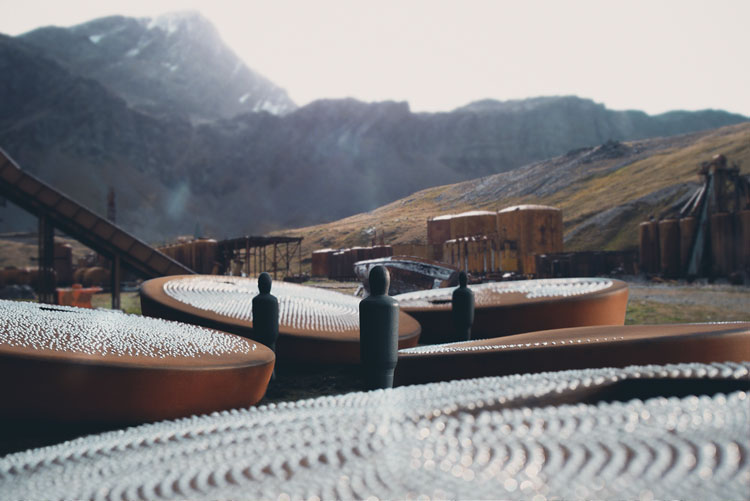
Michael Visocchi. The Spirit Tables of South Georgia. Photo composite by Adam Proctor © 2020.
JR: This gave you the name for the piece?
MV: Yes. The word commensal comes from the Latin commensalis, which means “together at the same table”, which sets up the idea that this is the way we have to do things – eat at the same table, humanity and wildlife, not harming each other.
JR: How do you plan to use the rivets?
MV: Looking at the round oil tanks [which held the whale oil] and the round cast-iron pots left from the seal hunting that preceded whaling (we are a class act!) that lie around at jaunty angles on South Georgia’s beaches, I thought perhaps the rivets could be displayed on low round tables set at different angles to catch the changing light.
These tables have become almost like a canvas for me, for the rivets. The whaling companies were quite forensic about the whales they caught, recording the numbers and the species. At first, I thought of expressing the numbers with a pie chart, but the pie chart is quite a blunt instrument. Nightingale charts are much more precise. These were used by Florence Nightingale to chart the deaths of soldiers during the Crimean war [data she hoped would contribute to reducing the death toll]. Completely by chance, the government then started talking about the Nightingale hospitals in the pandemic. It was really weird.
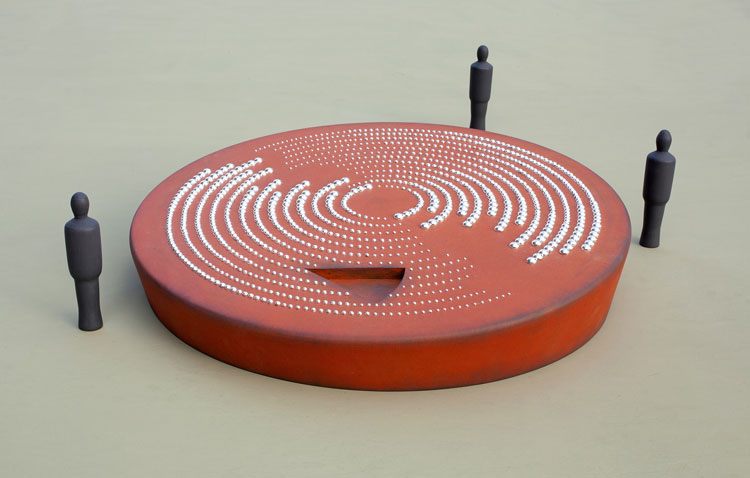
Michael Visocchi. Concept model for Humpback whale Spirit Table. © Michael Visocchi.
I wanted to compare the numbers of whales taken with the recovered numbers, but the first is accurate and the second isn’t and that wouldn’t really work. I now have a Key Table, which is a Nightingale chart – using rivets – of the numbers of each species that were taken – 87,555 Fin whales, 26,754 humpbacks etc. Then I have a Spirit Table for each of the six whale species persecuted and these evoke the spirit of each of the species that has recovered.
On the perimeter of each table, there will be some information about the species and a measurement of its size. For example: “This table x 2.5 is the average size of a humpback whale.” I’ve tried to use the arrangement of the rivets on each table to hint at the natural history of the species. For example, the humpback whale is known for creating spiral bubble nets to catch krill, so their table has rivets in a spiral configuration. I’ve made a crescent moon [of rivets] for the southern right whale because it feeds at night. Each Spirit Table will also have a depression, a trench that represents the losses. That directly references the key table, so the viewer can make that connection between the loss and the hope in the recovery.
The rivets are shiny, so they reflect the sky, the mountains and the viewer. Hopefully, you will see them reflecting in the distance as you approach by sea. The domed surface of the rivets references the dorsal fin of whales as they break the surface of the water. Sometimes these things just all come together.
JR: What are the materials? They will have to be very hardy to survive the harsh climate in South Georgia.
MV: The rivets will be marine-grade stainless steel, the tables Corten steel, both of which are weather resistant. When Corten steel rusts, it forms a protective layer that prevents further degradation. The Angel of the North is Corten steel and the American sculptor Richard Serra uses it a lot. It reflects the language and the patina of what is already on the site.
JR: I believe you are also planning to use some original rivets from the site?
MV: Yes, I’m keen to try to use some of the original rivets that were left in stores at Grytviken. I’d like to use them on the Key Table, but this may not be practical. The old rivets would have to be shipped back to the UK to be adjusted and fitted.
JR: Will it all be made here in the UK?
MV: Yes. I’m very much a maker. I usually make everything myself, but this project is beyond my facilities so the tables will probably be made in Sheffield. There is an engineering shop near me [in Angus] with a computer-controlled lathe, which I hope will make the rivets.
JR: Does it bother you that the audience that will see the work “in the flesh” is inevitably limited?
MV: About 10,000 people a year usually land at South Georgia (although it is currently closed due to the pandemic). I have sometimes wondered how many people see my work in the City of London [Gilt of Cain] – which is down a little alley – and whether, ironically, more people might see the work in South Georgia. Interestingly, I’ve never seen one of my favourite artworks. I’m obsessed with Constantin Brâncuși’s Sculpturale Ensemble at Târgu-Jiu in Romania. I’d probably be disappointed now if I go to see it because I’ve so long imagined how the sculpture group works.
We are thinking about ways of involving more people in the South Georgia work. There is talk of putting a webcam in the Flensing Plan and, although it’s early days, I’m investigating the idea of bringing a part of the work to other places that had a connection with whaling in Europe and North America. This would create more chance for people to see it and engage with the story. This is all to be worked out in the coming year.
JR: And draw attention to South Georgia and your message? Do you have an aim beyond the pure art in this project?
MV: Very much so. This work is very much about the message: we are all at the table together and we have to make space for each other. That’s really the only way forward I can see for us all.
JR: You have long had an interest in environment themes and in landscape, the natural world and the human footprint on it. What first drew you to these themes?
MV: I’ve been thinking about this quite a lot recently. When I was young, not only was I watching David Attenborough but, when I was off school ill, I watched a documentary about the 1989 Exxon Valdez [oil spill] disaster. I remember being devastated by it and aghast at the folly of humans. Not long after that, on the television, I saw Local Hero – Bill Forsyth’s wonderful poetic Scottish film, which is also about the oil industry, and I remember making the connection between these two. The Local Hero story was almost played out years later with Donald Trump and his golf course in Aberdeenshire and the gentleman on the beach who wouldn’t give up his land.
I saw these films while I was making things. I made things throughout my childhood. I grew up behind the counters of the shops and cafes my parents ran and there was always cardboard to play with, and Sellotape and scissors. And lots of colours as well actually. I’m still really interested in colour.
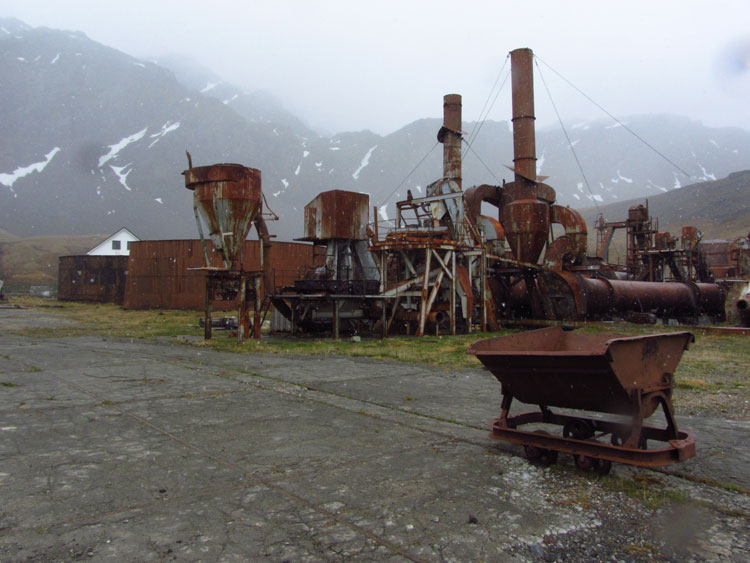
Grytviken, South Georgia. Photo: Juliet Rix.
JR: You quickly picked up on the colour of Grytviken and South Georgia, didn’t you?
MV: Yes, that rusty colour. Colour is not always associated with sculpture. I remember a sculptor telling me early on that it’s difficult to use colour and form, and I think that put me off for a while. I now think that was bad advice and I do use colour and I’ve got more confident doing that in the last few years. I think, traditionally, there’s been the feeling that colour in sculpture is not “pure”, that sculpture is about form. It probably goes back to the thinking that classical sculpture was monochrome – which we now know it wasn’t. Colour tends to be seen as the realm of the painter.
JR: Why should it be?
MV: Maybe it’s just a hang-up from art school. In public art sculpture, it is harder to use colour. You need materials that are long lasting – self-coloured.
JR: How different do you find working on a public art commission and your own work?
MV: It is different. I generally work in the studio on my own practice, which seems to have no beginning or end, it’s a continual thing. But, to survive, I need to work on commissions and I find them interesting. You have a brief, like a designer has, and that is quite good for me, for my brain. For a while you immerse yourself in a subject – like the slavery story or the whaling story. You get to talk to people you would never normally talk to, like a whaling expert at the British Antarctic Survey. And you can connect with the world in a more direct way. It’s a particular audience that goes to see art in galleries, but public art connects with a wider audience and that appeals. And in the case of the South Georgia commission, it feels like a chance to potentially affect people for the better – showing what we got wrong, but also what we can get right.
One of the exciting things about sculpture, especially outdoor sculpture, is that you don’t have total control over how it is seen. A painting is seen in a much more controlled environment. Sculpture can’t do prescriptive narrative; it has infinite angles, light, weather, sound. Sculpture therefore lends itself to memorials and dealing with quite difficult subjects. I wonder if that’s why it’s had a public role since the Ancient Egyptians, the Greeks …
My studio work is generally influenced by landscape and the natural world, and is more, if it doesn’t sound too pretentious, poetic rather than message driven. More contemplative. It’s about the gaps between things, about boundaries, it’s about the liminal.
JR: What are you working on besides the South Georgia commission?
MV: I’m making 77 Christian crosses for a new Church of Scotland church in Sighthill, Glasgow. Many people seeking asylum in the UK were – and still are – welcomed to Glasgow. The local authority there initially tended to rehome these people in the Sighthill area, in the north of the city. Many joined the local church, St Rollox, and the church began to devote a large part of its ministry to helping these people, some of whom may have become isolated or destitute as a result of government policy, some caught up with sanctions affecting their access to universal credit and other benefits. It’s a pretty extraordinary church and congregation. Most of its members have come from countries in Africa and the Middle East. The church has an incredible minister.
A compulsory purchase order for a regeneration project meant the church was demolished, so money was provided to build a new one and for an art commission.
I’m not religious, but I grew up a Catholic, so I’m acquainted with all the visual imagery and I’m interested in religion and the role of art in churches. I’ve always loved crosses – their form – and discovered they go back long before Christianity. There are hundreds of different crosses and this church’s congregation comes from such a variety of backgrounds. So, I proposed to cover one entire exterior wall of the church in a variety of cross designs suggesting the diversity of the congregation who worship behind it. En masse, they look fairly minimal and geometric, but each of the crosses has its own heritage.
JR: Are you making all the crosses yourself?
MV: Yes. My studio is also a workshop. It’s a bit mad really. I’ve made rather a rod for my own back. It’s taking ages – a couple of years – but I hope to have it all installed by Easter. It should look impressive and, hopefully, will mean something to the congregation. I find a lot of public art doesn’t seem to mean much. I hope this will.
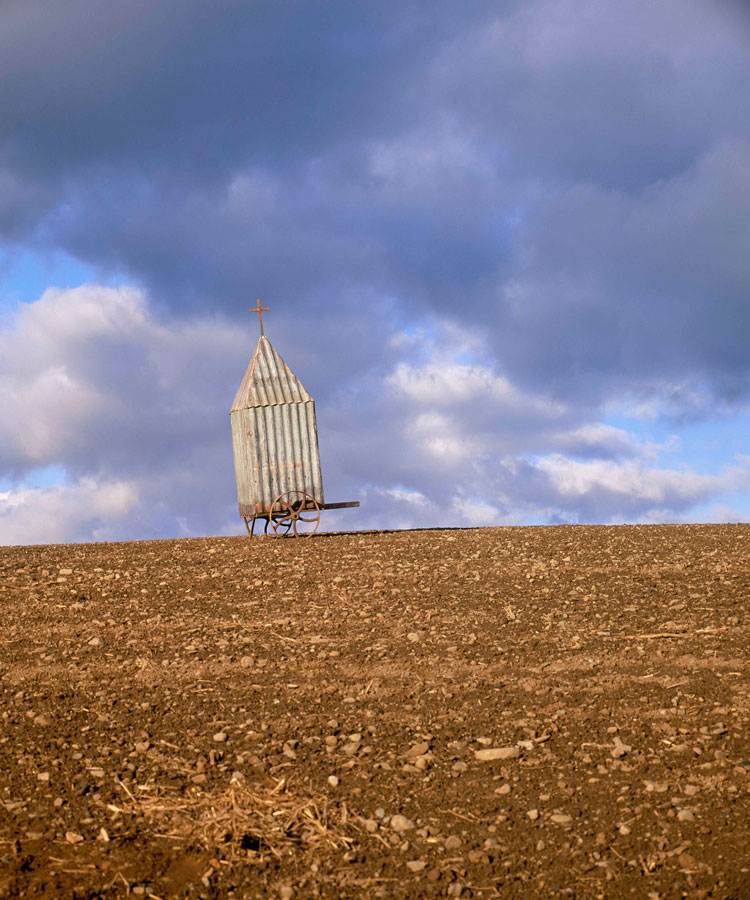
Michael Visocchi. Calvinist Implement, 2001. Photographic work. Temporary sculpture placed in landscape. Steel, wood. Photo: Michael Visocchi.
JR: Are you working on anything else?
MV: I was given some money a few years ago to produce a publication of my work, a book. I have a wonderful designer in London and a collection of essays to go in it. It’s a chance to compile a survey of my work to date and have everything side by side for once.
I also do a bit of 2D work – photography, including photographing my studio work in different contexts. I make temporary constructions that I assemble in different locations and the photographs become the artworks. Sculpture can be very laden and time-consuming. It’s nice to do something more spontaneous.
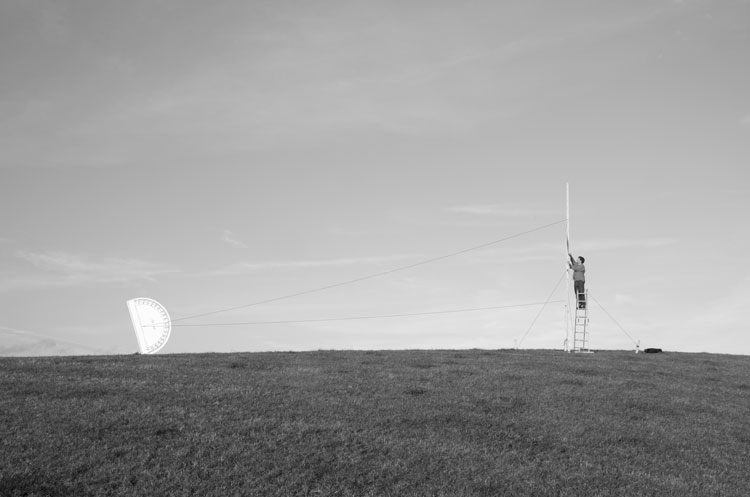
Michael Visocchi. Untitled. Field set up with protractor from Denis Diderot. Photo: Julia Carson.
I’ve also been thinking about some prints to go alongside the South Georgia project. I love Christo and Jeanne-Claude’s work. Last time I was in London (which shows you how long ago it was!), they were putting up his Serpentine installation [London Mastaba] and I talked to the assistants doing it about how they were fixing it together. Christo was an amazing artist and he did beautiful drawings of his proposals for his massive installations and sold them to raise the money for the projects. Perhaps I could do something like that.
JR: What is the timescale for Commensalis on South Georgia?
MV: I can’t go this year because of the pandemic, so I hope to go at the start of next season [in their spring] in October 2021. I’m really looking forward to it. I hopefully start fabrication in 2022. It’s going to be quite a long-term project.
• You can listen to Michael Visocchi talking about the South Georgia commission here and
to David Attenborough introducing South Georgia here.